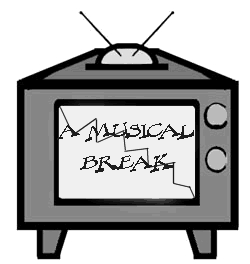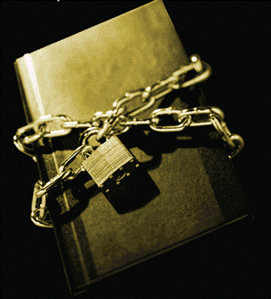Thank you Delta Sierra for authoring this post!
Censorship is a tricky thing…or is it? Every day we come across things we wish we didn’t know existed. Skinheads? Ugh, repulsive, don’t tell me about them. A book giving instructions on how to blow stuff up with ordinary household substances? Ugh, disgusting, suppress it. But, maybe it’s a good thing information like that gets out there, so people can know what evil there is in the world. How else can they develop critical thinking?
After a long time wrestling with this, I’ve boiled it down to my own soundbite: the act of censoring is worse than that which is censored. Especially when you consider that most books are banned for reasons of sex and politics. (I’m including religion in with politics.)

Here’s a brief quiz. The numbered items tell which country a well-known book was banned in, and why. Can you work out the titles? Answers appear at the bottom (DON’T CHEAT).
1. This 1865 novel was banned in the province of Hunan, China, in 1931 for showing animals functioning on the same level as human beings. It has also been banned in other places for supposedly promoting drug use.
2. This 1929 novel describes the life of an ordinary German soldier in WWI. The author was himself a veteran. It was banned and burned in Nazi Germany for being demoralizing and insulting to Germany’s military forces.
3. A novel published in 1988. Banned in many countries. Bookstores were bombed for carrying it. People died in riots over it. In 1992, western publishers formed a consortium to publish and distribute a paperback copy, to forestall any one publisher being targeted. Not the author’s first run-in with pissed-off authorities. In 1991, this title’s Japanese translator was murdered for having been involved with it.
4. This book was ready for publication around 1940, but did not appear in print until 1945. The reason: the book is highly critical of corrupt leaders, and the Allies in WWII thought the U.S.S.R. might get a bit touchy about it. A play based on it was banned in Kenya in 1991. In 2002, the United Arab Emirates schools banned it for having images that go against Islamic and Arab values. Although anyone who bought a copy in 1945 would be a happy camper. Had they kept in it good condition, it would worth upwards of $10,000.
5. Published in 1932, this dystopian novel has been ticking people off ever since. Ireland banned it in 1932 for sexually explicit scenes and offensive language. It has been accused of being anti-family and anti-religion.
6. Banned all over the place since it was written, in 1928. The author couldn’t find a publisher in the U.K. who would take it, so it was effectively banned there before it was even published. He had it privately printed in another country, just 1,000 copies. Don’t you wish you had one today: in good shape, it’s worth well over $15,000. In 1960 there was a successful court trial in London as to whether or not it could be published. Since then, it has been widely available. John Mortimer, author of the Rumpole of the Bailey series, was involved in the trial, and with other freedom of speech trials, including one about the Sex Pistols.
7. This novel, published in 2003, annoyed the Vatican intensely, although I can’t find that it was ever actually on the Index Librorum Prohibitorum. The primary criteria for getting on The Index are anticlericalism, blasphemy and heresy. Lebanese Catholic leaders did ban it in that country, deeming it offensive to Christianity.
8. Banned in the U.K. and the U.S. Had two small print-runs in the U.K. before being banned. Surviving copies from its year of release, 1928, are very scarce. Was the subject of several obscenity trials due to lesbian themes.

To give us a little space between the quiz questions and the answers, here is another list for you to shake your head over. It’s the American Library Association’s 2010 list of most-challenged books. The dear ALA, which does a lot more than organize shushing lessons for trainee librarians, maintains the Office of Intellectual Freedom. Office of Intellectual Freedom, doesn’t that have a lovely ring to it? Imagine working for them, storming into a book-banning PTA meeting and whipping out a shiny steel badge. “Hands in the air! OIF! We’re bustin’ this shit up.” The OIF receives reports from media, librarians and teachers of books challenged in the U.S. In the OIF’s words, “A challenge is an attempt to remove or restrict materials, based upon the objections of a person or group. Challenges do not simply involve a person expressing a point of view; rather, they are an attempt to remove material from the curriculum or library, thereby restricting the access of others.”
Can I also just mention that regular bookstore and library employees have to deal with book-challengers? If you’re on the floor you need to get used to people motoring up to you wanting to know why you carry insert-evil-book-title. Or why you don’t carry insert-title-of-beloved-but-probably-insane-book. Oy.
ALA’s most-challenged books from 2010:
“And Tango Makes Three” by Peter Parnell and Justin Richardson. Reasons: Homosexuality, Religious Viewpoint, Unsuited to Age Group (“Unsuited to age group” denotes a book aimed at children or young adults that has been challenged as not being suitable for the target age.)
“The Absolutely True Diary of a Part-Time Indian” by Sherman Alexie. Reasons: Offensive language, Racism, Sex Education, Sexually Explicit, Unsuited to Age Group, Violence.
“Brave New World” by Aldous Huxley. Reasons: Insensitivity, Offensive Language, Racism, Sexually Explicit.
“Crank” by Ellen Hopkins. Reasons: Drugs, Offensive Language, Sexually Explicit.
“The Hunger Games” by Suzanne Collins. Reasons: Sexually Explicit, Unsuited to Age Group, Violence.
“Lush” by Natasha Friend. Reasons: Drugs, Offensive Language, Sexually Explicit, Unsuited to Age Group.
“What My Mother Doesn’t Know” by Sonya Sones. Reasons: Sexism, Sexually Explicit, Unsuited to Age Group.
“Nickel and Dimed: On (Not) Getting By In America” by Barbara Ehrenreich. Reasons: Drugs, Inaccurate, Offensive Language, Political Viewpoint, Religious Viewpoint.
“Revolutionary Voices” edited by Amy Sonnie. Reasons: Homosexuality, Sexually Explicit.
“Twilight” by Stephenie Meyer. Reasons: Religious Viewpoint, Violence.
In case you’re interested, the real skinny on Sarah Palin and the Alaska book-banning seems to be that, when mayor of Wasilla, she asked Mary Ellen Emmons, of the city’s public library, how she felt about banning certain books. No titles were mentioned. Dear Ms. Emmons, of course, told her she didn’t think too much of it at all, she was against it. Really strongly against it. No books were actually banned under Palin’s mayoral regime.
Here are the answers to the quiz questions:
1. Alice’s Adventures in Wonderland, Lewis Carroll.
2. All Quiet on the Western Front, Erich Maria Remarque.
3. The Satanic Verses, Salman Rushdie.
4. Animal Farm, George Orwell.
5. Brave New World, Aldous Huxley.
6. Lady Chatterley’s Lover, D.H. Lawrence.
7. The Da Vinci Code, Dan Brown.
8. The Well of Loneliness, Radclyffe Hall.
How did you do?

